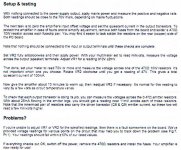Hello James 
I did a search. Could not find any info of this 500 watt amp from 1997.
From their website http://www.siliconchip.com.au/ they recommend Studio 350, before the 500w, because 350 have lower distortion and supposedly better sound quality.
This one delivers max 350 Watt into 4 Ohm.
The difference between 500w and 350w? .... 1.5 dB sound pressure!!!!!!
Now, if you know anything about stepped volume controls, then you also know we often use 2-3 dB steps,
because it is hard to hear such small differences in volume as 1.5 dB.
Studio 350 Power Amplifier Module
'studio 350' description is easy to find.
I downloaded one 'Silicon Chip Magazine' -torrent ... with many projects in a large shared file.

Some links:
Sildeshow Gallery w. schematics, details
http://us1.webpublications.com.au/static/images/articles/i1005/100503_4mg.jpg
http://us1.webpublications.com.au/static/images/articles/i1005/100503_15mg.jpg
I did a search. Could not find any info of this 500 watt amp from 1997.
From their website http://www.siliconchip.com.au/ they recommend Studio 350, before the 500w, because 350 have lower distortion and supposedly better sound quality.
This one delivers max 350 Watt into 4 Ohm.
The difference between 500w and 350w? .... 1.5 dB sound pressure!!!!!!
Now, if you know anything about stepped volume controls, then you also know we often use 2-3 dB steps,
because it is hard to hear such small differences in volume as 1.5 dB.
Studio 350 Power Amplifier Module
'studio 350' description is easy to find.
I downloaded one 'Silicon Chip Magazine' -torrent ... with many projects in a large shared file.

Some links:
Sildeshow Gallery w. schematics, details
http://us1.webpublications.com.au/static/images/articles/i1005/100503_4mg.jpg
http://us1.webpublications.com.au/static/images/articles/i1005/100503_15mg.jpg
Re: We described a 500W amplifier in the August, September & October 1997 issues of SILIC
If you really want it I can scan it in a few days. I definitely have the issue you're after but it's well packed away in one of several large boxes full of old issue magazines, so it's going to take a bit of time to find it. As stated above, these modules were intended more for PA, loud parties or sub woofer duties than for high fidelity stereo.
Another option for high power would be to build 4 xvSCLD2 modules and operate pairs of them in bridged mode. That would also give you about 500W pc into 8 ohms.
cheers, vm
jamesfeline said:Hi
has any one got a copy of this amplifier? it was a silicon chip 500w power amplifier.
any chance some one could send me the details
many thanks
Nick
If you really want it I can scan it in a few days. I definitely have the issue you're after but it's well packed away in one of several large boxes full of old issue magazines, so it's going to take a bit of time to find it. As stated above, these modules were intended more for PA, loud parties or sub woofer duties than for high fidelity stereo.
Another option for high power would be to build 4 xvSCLD2 modules and operate pairs of them in bridged mode. That would also give you about 500W pc into 8 ohms.
cheers, vm
- Status
- This old topic is closed. If you want to reopen this topic, contact a moderator using the "Report Post" button.
- Home
- Amplifiers
- Solid State
- We described a 500W amplifier in the August, September & October 1997 issues of SILIC
